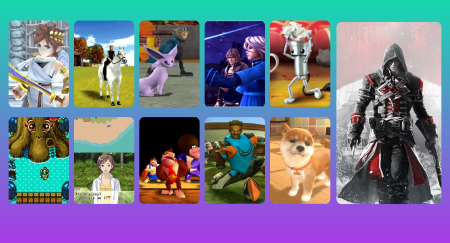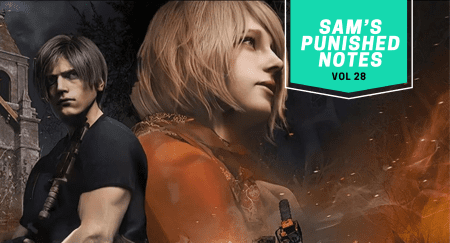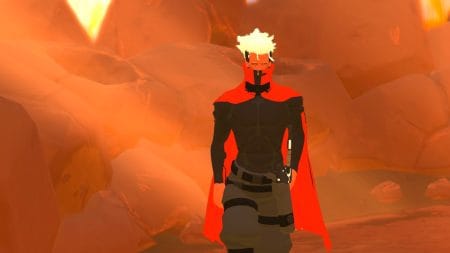More than 20 years ago, Nintendo unleashed a brand-new handheld device that would go on to change the medium in ways most would only recognize years later. The Nintendo DS, with its dual-screen display, clamshell design, and touch capabilities, launched to moderate success but ultimately became Nintendo’s best-selling gaming device, with all different types of DS models collectively selling over 154 million units.
Any Nintendo platform is home to dozens of incredible gaming experiences, but the DS offered more than just a vast library of great games; it reinvented and reimagined what it even meant to play a game. The two screens allowed for expanded UI options and more creative approaches to visual design; the touchscreen meant entire games could be played without the single press of a button, years before smartphones would seize the casual gaming market; the new graphical capabilities—for their time—allowed for fully 3D handheld experiences; and the built-in Wi-Fi meant players could easily access multiplayer options anywhere they went.
Also, the games themselves were really cool! In addition to classic Nintendo fare, the DS offered players the chance to try out experiences they otherwise couldn’t access on traditional consoles, often with unconventional and innovative control schemes. Even the most bog-standard role-playing games and platformers benefitted from the second screen, making otherwise predictable titles feel all the more special. (We even inducted the DS into our Punished Hall of Fame.)
Many of us at The Punished Backlog have a particular fondness for the DS and the games that carried it to gaming immortality. While there’s a faint sadness in knowing that dual-screen gaming may have gone the way of the Dodo, it’s good to remember just how special this little handheld device really was.
– Written by Sam Martinelli
The 16 Best Nintendo DS Games of All Time
From RPGs to visual novels, survival games to platformers, here are 16 of the top Nintendo DS games ever made.
Want to hop to a specific entry on our list? Here’s the full list in alphabetical order:
- 999: Nine Hours, Nine Persons, Nine Doors
- Chrono Trigger
- Elite Beat Agents
- Grand Theft Auto: Chinatown Wars
- Hotel Dusk: Room 215
- Lost in Blue
- Mario Kart DS
- New Super Mario Bros.
- Nintendogs
- Phoenix Wright: Ace Attorney – Trials and Tribulations
- Pokémon Black/White
- Pokémon HeartGold/SoulSilver
- Resident Evil: Deadly Silence
- Super Mario 64 DS
- Tetris DS
- The World Ends with You

999: Nine Hours, Nine Persons, Nine Doors
When 999 released in the West in November 2010, it was a revelation. A horror visual novel from the mind of Kotaro Uchikoshi (Ever 17), Nine Hours, Nine Persons, Nine Doors caught many Nintendo DS owners by surprise with its sharp writing, sharper twists, and constant dread.
The game’s title says it all. Set on a sinking cruise ship, 999 tells the story of nine people who will die in nine hours unless they participate in a set of twisted challenges known as the “Nonary Game,” facilitated by a masked psychopath named Zero. Fail these trials, or attempt to escape without playing, and bombs planted inside each character will explode.
As protagonist Junpei progresses through the game, he forms tenuous alliances with his fellow contestants and discovers their tragic backstories, all while trying to ascertain Zero’s identity. Beyond the story—which is a terrific mystery that’ll keep you guessing—999 also features various escape room puzzles, each exceptionally clever.
It all results in a game that transcends the typical “visual novels are boring” critique, keeping players glued to the screen in search of that next clue that will unravel the entire plot. By the time you’ve learned the true identity of Zero, you’ll be clamoring to play the other games in this acclaimed collection.
– Written by David Silbert

Chrono Trigger
Chrono Trigger may not have originated on the Nintendo DS, but that shouldn’t detract from this version’s greatness. Released in 2008, Chrono Trigger (DS) marked just the second time Square Enix’s legendary RPG had been ported to new hardware—the first being the 2001 PlayStation port.
Unlike later ports, which suffered from poor controls, ugly interfaces, and numerous other oddities, the DS version of Chrono Trigger retained the original look and feel of the SNES classic. The game translated magnificently to Nintendo’s dual-screen hardware, allowing for battles to play out on the top screen with the most critical information—health bars, attack commands, etc.—consolidated to the touch screen.
The DS version retained the excellent anime cutscenes from the PSX port while cutting down on load times considerably. Other quality-of-life improvements—like touch controls, a new English translation, and a map screen—only made this version more impressive. A few added dungeons didn’t resonate with fans nearly as well, but when the rest of the game is so good, who really cares.
Chrono Trigger is one of the greatest games of all time. The DS game improves on it and puts it in the palm of your hand. It doesn’t get much better than that.
– Written by David Silbert

Elite Beat Agents
A spiritual sequel and international counterpart to Japan’s Osu! Takae! Ouendan, Elite Beat Agents might be the greatest rhythm game of all time that doesn’t require a fake plastic instrument. Masterfully utilizing the DS’s touch-screen controls, Elite Beat Agents presents a totally bonkers gameplay concept—a team of secret agents must absolutely nail dance moves in order to inspire everyday people (and sometimes animals) to solve their problems—and executes it nearly to perfection.
The scenarios are hilarious on their own. In one instance, you help a pair of ditzy young women survive on a deserted island by convincing local animals to fawn over them and treat them like royalty (the song, of course, is Madonna’s “Material Girl”). In another example, the agents dance their way through Earth, Wind & Fire’s “September” to help a mother literally prevent inclement weather from ruining her special day with her child. With every challenge, you have the touchscreen at the bottom throwing numbered icons you have to tap in the right order and cadence, while the top screen depicts the silly cartoons that serve as the backdrop for each song.
Fundamentally, Elite Beat Agents is silly, but there’s so much heart to it. Moreso than any other rhythm game I’ve experienced, it truly believes in the power of dance and music to change lives, even if it’s just helping a cat rescue a baby from a construction site while a Jackson 5 jam plays in the background. The game could only have existed at the time that it did on the platform it was released on, and I’m eternally grateful to have had the opportunity to experience it when I did.
– Written by Sam Martinelli
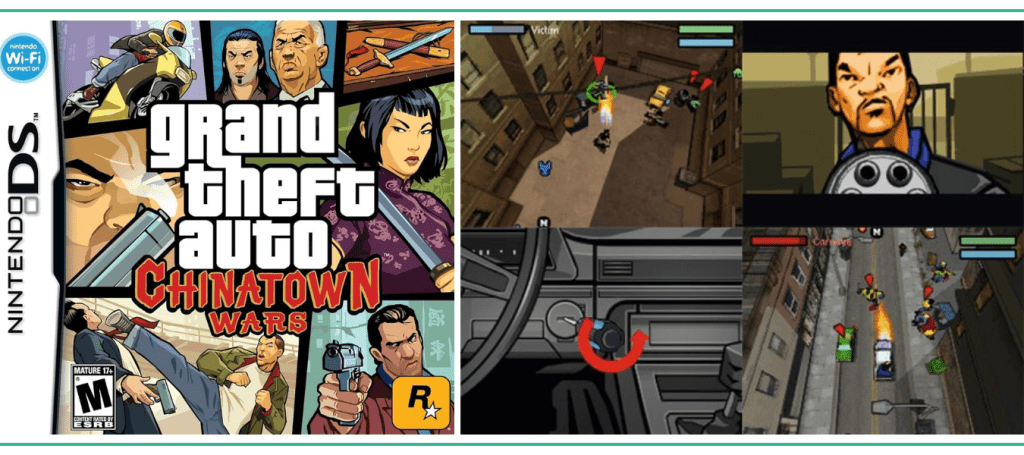
Grand Theft Auto: Chinatown Wars
Rockstar’s best Grand Theft Auto game released in 2009 for the Nintendo DS. Grand Theft Auto: Chinatown Wars combines the top-down view of classic PlayStation GTA with the DS handheld’s unique touch screen and microphone capabilities.
Grand Theft Auto: Chinatown Wars follows Triad member Huang Lee’s engagements with the Liberty City Police Department, as well as with various other Triads gangs warring for turf. The game featured action-packed and heartfelt moments that not only rivaled its console siblings but also any film released at the time.
Complementing the action was Chinatown Wars’ soundtrack, which combines a variety of styles and genres and still holds up today. This confluence of sound, paired with the thrilling crime story, elevated what was possible for third-party games on a Nintendo handheld.
I hope we’ll eventually get a port or remaster of Grand Theft Auto: Chinatown Wars for the Switch 2. For a game whose setting celebrates the influence and legacy of the late aughts, the idea of keeping this masterpiece relegated to the DS (as well as PSP, iOS, and Android via later ports) feels like dishonoring the past.
– Written by Clint Morrison, Jr.
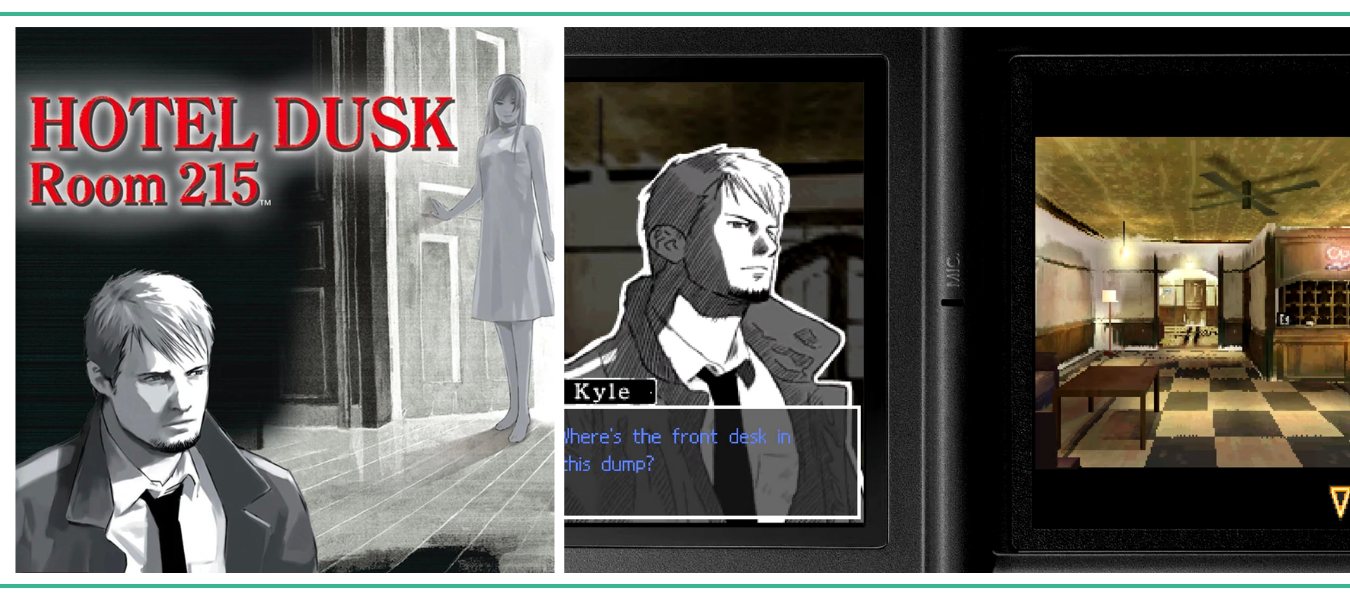
Hotel Dusk: Room 215
Noir is one of film’s more influential genres—yet one that’s sadly been lost in the transition to video games. For every game like L.A. Noire or The Wolf Among Us that nails the dark, jazzy, smoke-filled atmosphere of noir, there are a hundred pale imitations. Hardboiled detectives and femme fatales are table stakes; real noir cuts underneath the brood to show us more.
Hotel Dusk: Room 215 does just that. When Kyle Hyde’s former NYPD partner, Bradley, disappears without a trace, Hyde quits the force, heads west, and becomes a P.I.-for-hire. Three years later, Hyde receives a request to travel to the dusty, unremarkable Hotel Dusk—and with that chance visit, the cold trail to find Bradley suddenly gets hot.
There’s plenty of standard noir fare here: a gruff detective with a depressing background; suspicious hotel patrons, each with something to hide; dusty interiors and dimly lit hallways; even a jazz bar. But where Hotel Dusk elevates itself is in its embrace of innovative storytelling. One of the few Nintendo DS games that required holding the system sideways, Room 215 plays like an interactive novel. Dialogue reads like pages from a Kindle, with highlighted words players can drill into to have Hyde grill witnesses. Each character is brought to life with expressive rotoscope animation and music that rises and falls with the dynamics of the scene.
And then there’s Hyde himself—a man who puts on a brave front but is secretly an empath with a heart of gold. His witty sarcasm and genuine moments of vulnerability help shape Hotel Dusk into a terrific caper that’s so much more than the sum of its dusty parts.
– Written by David Silbert
PS: July 2025 Update — David wrote a new piece in Unwinnable Magazine about this game, “The Softboiled Allure of Kyle Hyde.”
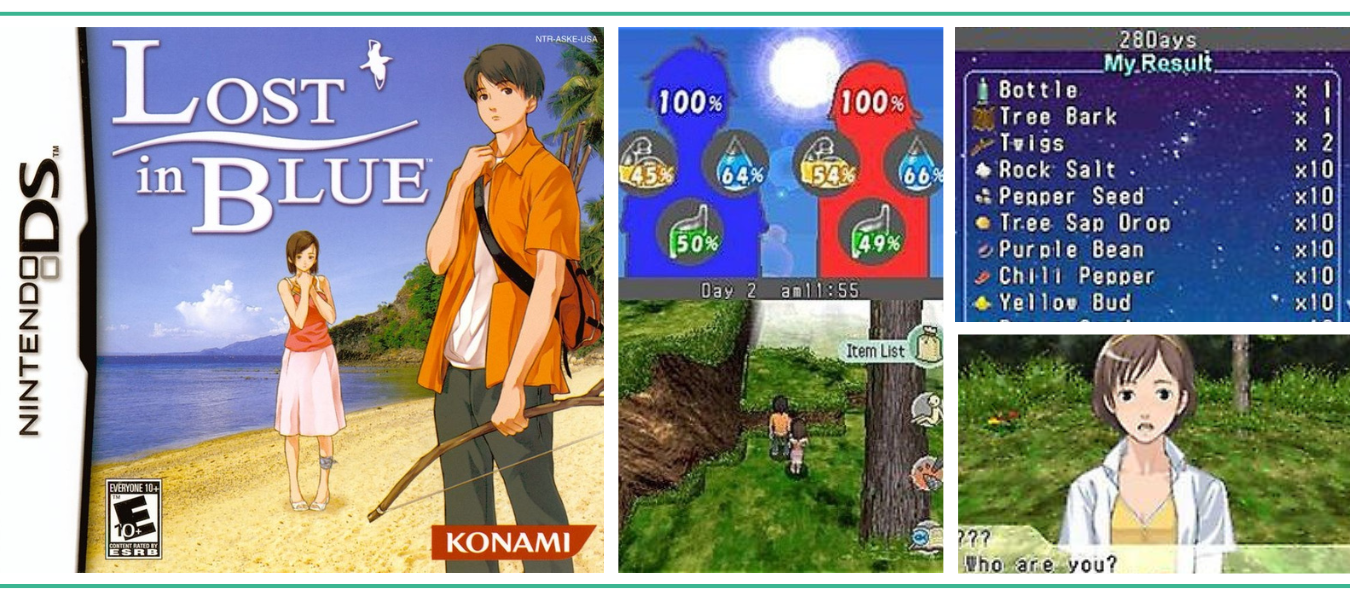
Lost in Blue
In the early 2000s, people were obsessed with the idea of being on a deserted island. It probably started in 2000 with Tom Hank in Cast Away. It was augmented by the hit show Lost (2004–2010), and even a kid-friendly Disney series knock-off, Flight 29 Down (2005–2007). But for me, the pièce de résistance of the movement was a 2005 Nintendo DS game.
In Lost in Blue, players take on the role of a young man who’s recently been shipwrecked on a deserted island. The only other survivor is a young woman he’s never met before. The two must work together to gather food, find clean water, build a shelter, fend off dangerous animals, get along, and maybe, just maybe, find some way off this stinkin’ island.
I loved the rhythm of this game. Every day was a chance to make new choices and build on the progress I’d made the day before. As I wrote on our most wanted video game remakes list, Lost in Blue made great use of the Nintendo DS’s technical specs. The top screen featured character health stats and a map, while the bottom screen portrayed character movement or the current action, like trying to spear a fish. Making a fire required blowing into the handheld’s microphone, and cleaning off shells necessitated gently using the touchscreen.
Despite being an avid gamer, I have yet to talk to anyone else who’s ever played Lost in Blue. I have a feeling the game and its sequel didn’t sell well, which was surprising to me. That cover art of two emo but determined youths on an island? That should’ve been 2005 gold! Am I on a deserted island of culture and taste?!?!?! Well… I know where at least one copy of Lost in Blue is: in a box I just unpacked, perfectly timed for a replay.
– Written by Amanda Tien
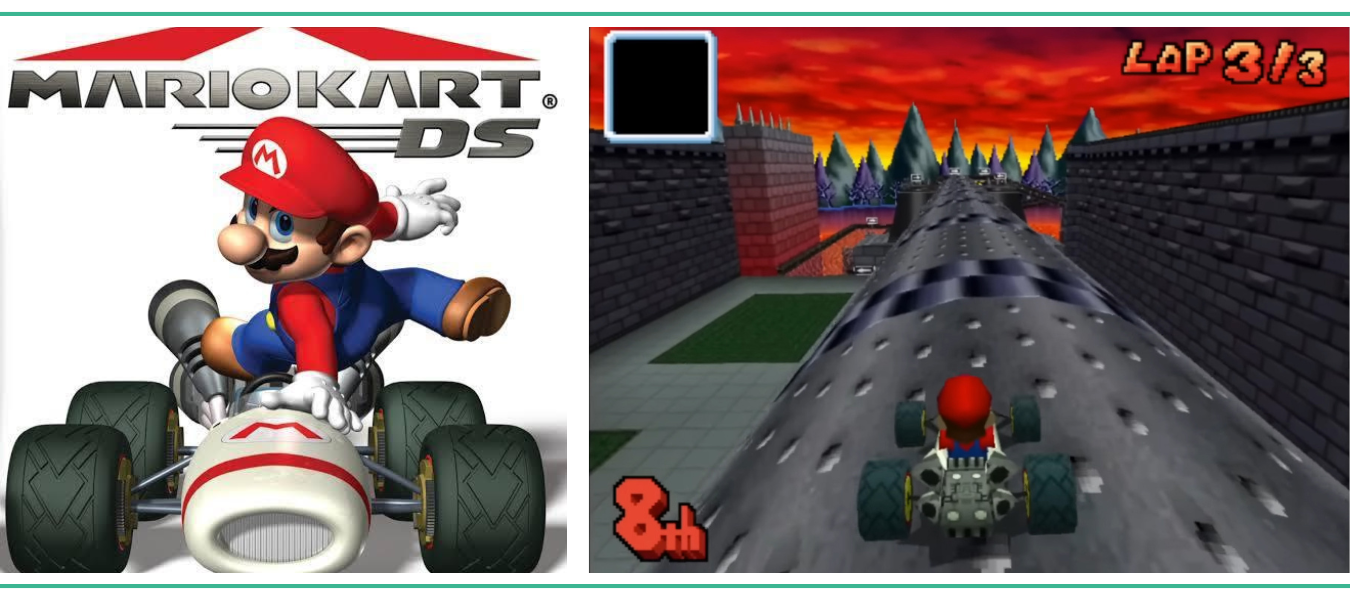
Mario Kart DS
A somewhat ironic element of the Nintendo DS story is that while it remains the best-selling game system Nintendo ever made and the second best-selling game console ever, not many of the top titles from classic Nintendo franchises made much of a lasting cultural dent. There are a few exceptions of course, the most notable of which is Mario Kart DS, to this day one of the best-selling games on the platform.
What was so special about Mario Kart DS? For starters… it was a handheld Mario Kart game that wasn’t Super Circuit. More importantly, though, it so perfectly fit with the DS’s philosophy that it felt at times like the franchise was designed for handheld play first and foremost. The dual-screen format meant the place standings and map could be on the bottom screen, leaving the actual racing screen on top largely unencumbered by a crowded UI.
Meanwhile, the built-in Wi-Fi capabilities of the DS meant Mario Kart DS was the first game in the series (and, let’s be honest, the first Nintendo game period) with high-quality, easily accessible online play. Also, Mario Kart DS followed a trend set by many other DS games in offering DS Download Play, where multiple DS owners within reasonable proximity could play multiplayer with a single Mario Kart DS copy.
Even beyond all the newfangled (at the time) technology that made Mario Kart DS so exciting, it was (and still is) one of the best Mario Kart experiences out there! The track designs are superb, the mechanics are as smooth as any game in the series to this day, and there’s even a (sort of) robust mission mode for players seeking more single-player content. Whether alone or with friends, Mario Kart DS represented so much of what made the Nintendo DS incredible.
– Written by Sam Martinelli

New Super Mario Bros.
New Super Mario Bros. on the Nintendo DS is hands-down one of my favorite 2D Mario games. Released in 2006 when the subseries was actually new, the game was an immediate sensation. It felt revolutionary to be playing a 2D Mario game with a touchscreen and stylus; compared to the Game Boy Advance era of Mario titles, New Super Mario Bros.’ graphics were clean, and the gameplay was the right amount of challenging. There’s even local multiplayer, so you can join friends!
New Super Mario Bros. also includes simple yet addicting mini-games for when you are over all the platforming. Remember Memory Match, where Luigi is a dealer in a casino? Chef’s kiss! Oftentimes, I only played the mini-games, as they’re something I’ve always enjoyed doing on my handheld consoles.
Even though it has been about 13 years since I last played New Super Mario Bros., I still look back on it with nostalgia. It’s my favorite Nintendo DS title that I owned, and after playing it for so many hours (especially the mini-games!) I can’t recommend it enough.
I hope 2D Mario doesn’t find itself in another slump once the successor to the Nintendo Switch is out. With Super Mario Bros. Wonder emerging as a smash hit in 2023, let’s hope Nintendo keeps up the momentum.
– Written by Allison McDaniel
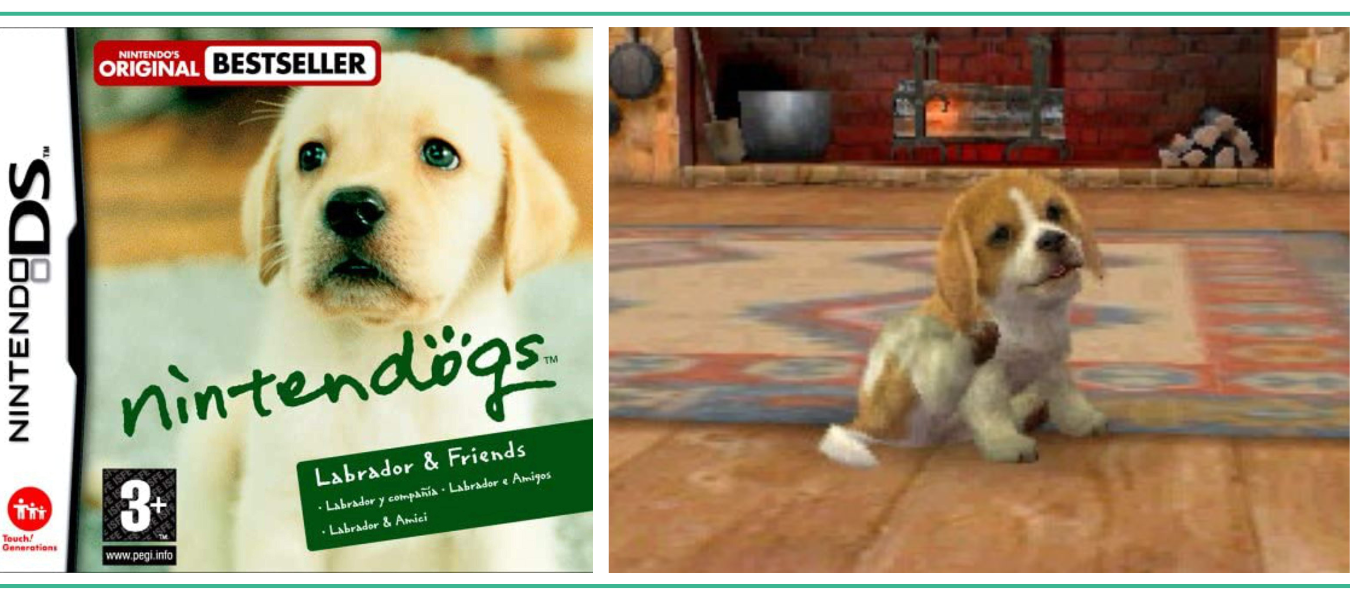
Nintendogs
“Come here, Lucky!” I shout-whisper in a crowded noisy hell-hole terminal of LAX airport. My parents ask me to please stop. “No, this is my dog! He’s learning!” And it’s true–he is learning. Lucky, a black Labrador puppy, hears me calling and turns around, happily running over to me. I whisper into the Nintendo DS microphone that he’s a good boy, and use the stylus to pet his head. I love this dog.
Despite always desperately wanting a dog, I’ve never had one. It was a mix of always moving and a family member’s allergies. I dreamed of an animal companion that would always be my friend, even if I was the new kid every year; I would never be lonely!
I played every dog game I could get my hands on as a kid, but Nintendogs was the first one that was really mobile, just the way that a real dog would be. Lucky and my other Nintendogs could come with me no matter where I was, whether it be on a plane or a car or yet another new school. I wasn’t the only gamer in love with the game! As we shared in episode one of the Punished Podcast, the Nintendogs franchise sold 2.69 million copies worldwide and is often credited with helping bring thousands of femme players to gaming.
The first Nintendogs game, Lab & Friends, released in April 2005 and was a smash hit. More titles released with many more pals such as Chihuahuas, Dalmatians, and later even cats. The franchise made great use of the microphone (to my parents’ chagrin), dual-screen, and touchscreen over a variety of activities. I haven’t played Nintendogs in years, but it still holds a special place in my heart. And when I finally got my real-life rescue puppy who learned to come when I called him, it really did feel like all my Nintendogs dreams had come true.
– Written by Amanda Tien
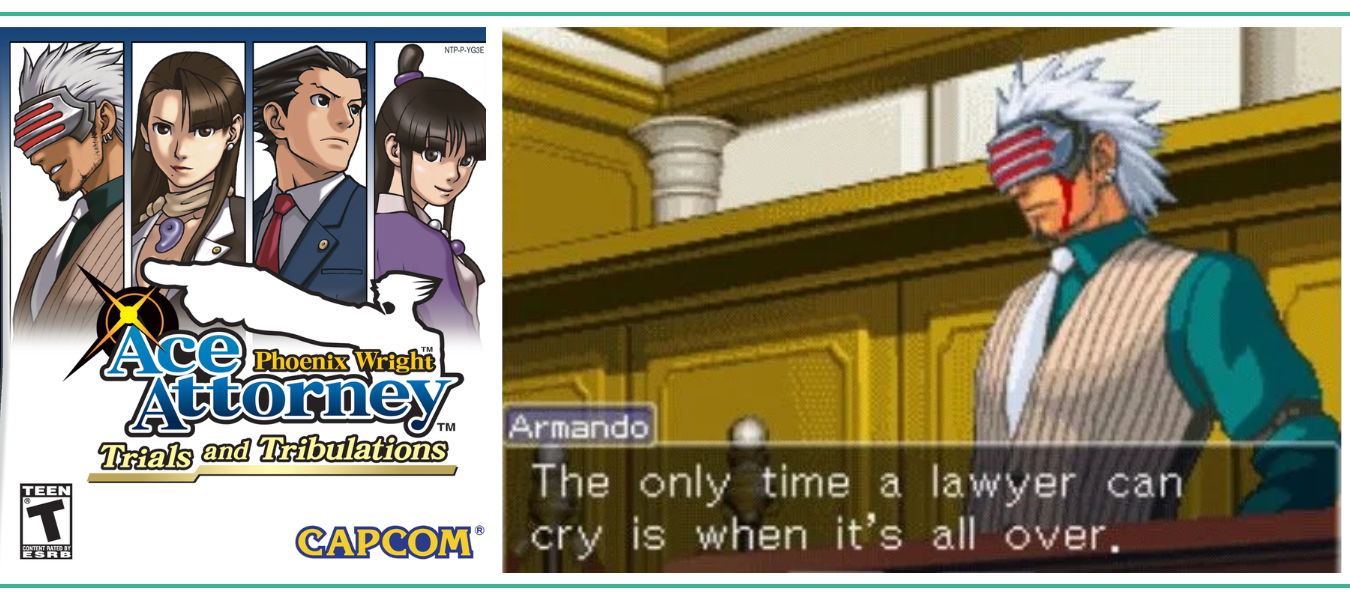
Phoenix Wright: Ace Attorney – Trials and Tribulations
Trials and Tribulations is the third entry in the Phoenix Wright: Ace Attorney trilogy, a charming series of visual novels that incorporates point-and-click mechanics into courtroom shenanigans packed with drama, pathos, and absurdity. You play as the titular Phoenix Wright, a young, plucky, in-over-his-head defense attorney who must defend his innocent clients against scheming and conniving prosecutors with the help of his spirit medium sidekick.
What sets Trials and Tribulations apart from the rest of the trilogy—and the rest of the series—is its heavy sense of finality. Its final case, Bridge to the Turnabout, is a more than fitting send-off for a narrative that has been slowly building for an entire trilogy. Featuring emotional closure for many of the recurring characters in the series and closing the narrative thread on the saga of Kurain Temple and the Feys, it remains the most emotional entry in the series.
The pervasive sense of conclusion permeates the entire game’s DNA, and is especially apparent in its soundtrack, which is notably more somber and serious than its predecessors. To this day, this game’s “Trial” theme never fails to inspire in me a swell of emotions. Never has a quote so captured the spirit of Ace Attorney so well as Godot’s closing line: “The only time a lawyer can cry is when it’s all over.” Does it make sense? No. But it’ll never fail to tug at my heartstrings.
Every entry in the series has its merits, and newer entries might even surpass Trials and Tribulations in pure quality. But the trilogy-spanning conclusion of Bridge to the Turnabout makes it an unforgettable entry in the franchise and one of the best Nintendo DS games of all time.
– Written by Keisuke Isobe

Pokémon Black/White
Ok, here’s the deal: I loved Pokémon Silver, but after that, I became a cocky kid who got “too old” for Pokémon. I skipped out on Generations III and IV (I did later play them either on emulator or via remake). That’s on me. I thought I knew better.
Anyway, fast forward a little. I was in high school when I heard yet another Pokémon game was coming out: Black and White. “How original,” I sarcastically thought. But I got a weird feeling when I started reading up on it, a feeling that I hadn’t felt in years. Suddenly, I had outgrown my “holier than thou” position. I wanted to play this game. I needed to play this game.
And so, off we were on another adventure, this time to the Unova region. The promise was great: 150 entirely new Pokémon. No repeats in the main game—all new. This was the closest we’d get to the feeling we had when playing Red and Blue for the first time.
And honestly… the new monsters were actually kind of forgettable. Very few stood out. But the crazy thing is, it didn’t matter. The world was amazing. I fell in love with Unova; It felt like I was reliving my days exploring Kanto and Johto, but with some small tweaks that really made it feel refreshing and new. One of my favorite moments in gaming is the walk into Castelia City over the Skyarrow Bridge. The slow pan across the bridge to reveal the massive skyline combined with the magical music that screamed newfound possibilities made me realize, for the first time, that Unova is more than a flat map. This was a real world, with living, breathing people going about their lives, and my journey is nothing more than a blip as I explore this massive city and its region.
Pokémon Black immediately recaptured my heart and reminded me why I loved Pokémon. I haven’t played every game since, and there are some that I could barely scratch the surface of without quitting *cough* Scarlett *cough*, but this game will always hold a place in my heart for making me feel something about this series again.
– Written by Mark Bowers
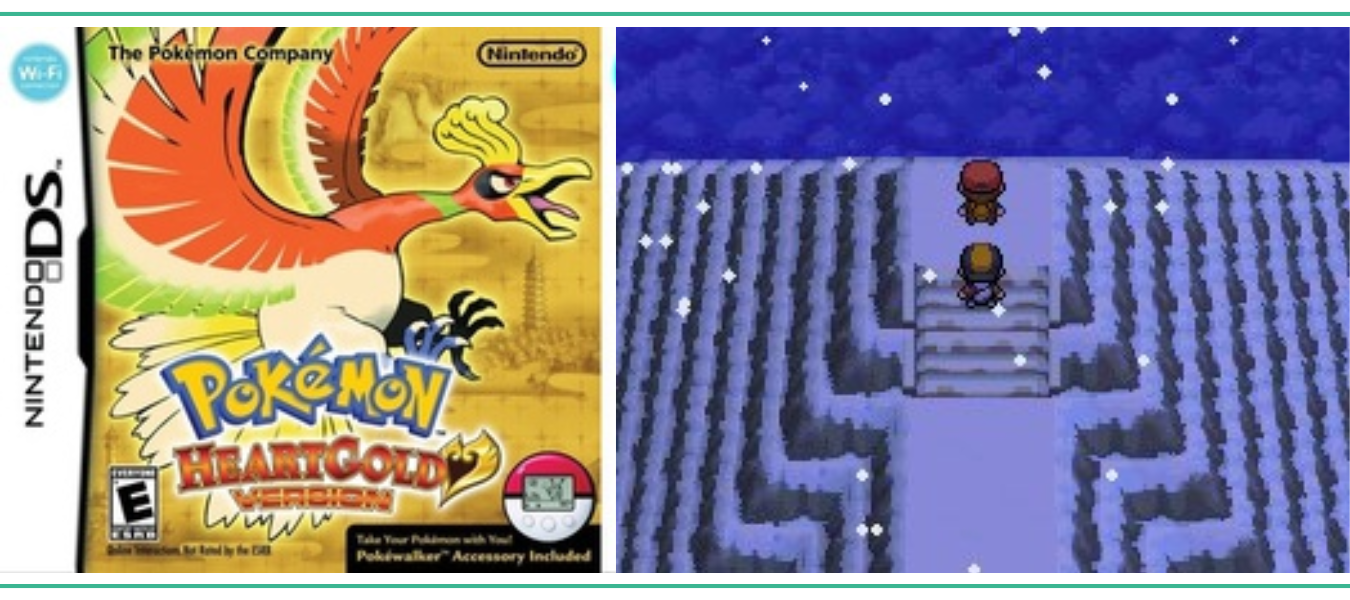
Pokémon HeartGold/SoulSilver
Cards on the table—this is really just a way for me to cheat and write a tribute to the original Gen II games. Pokémon Silver was my first favorite game. Everything about it was better than Gen I, and it completely captured my imagination. From the new starters (I rode and died with Feraligater) to the sensational legendaries, this is a sequel that truly delivered.
Fast forward a decade or so, and I was really feeling the itch to play my favorite game again. The problem was, my Game Boy cartridge’s save file was toast. How was I supposed to relieve this game with the saving ability gone forever? I couldn’t just restart the game every time I wanted to play.
Enter SoulSilver. Not only did this remake recapture the spirit of the original game, but it made it better than ever. The little things made a huge difference—a fully redesigned world, my Pokémon following me—but where the game excelled most was at bringing me back to what made me love it in the first place. Everywhere I looked, I was reminded of classic moments like Red Gyarados, discovering secrets I hadn’t found before, and, of course, driving toward that epic postgame.
It’s not just that SoulSilver reminded me how much I love the original. It reminded me of a time when gaming was new to me, when it was unique, and, frankly, a phenomenon. It’s hard to recapture that even with the greatest games of modern times. I am forever grateful that I had the chance to live out that feeling again.
– Written by Mark Bowers

Resident Evil: Deadly Silence
In 2006, Capcom released a Nintendo DS remake of the original Resident Evil. This was the second time that Nintendo players could experience the original game—the first being Resident Evil (2002) on GameCube. Hot take: Resident Evil: Deadly Silence is the superior version of the original game.
With Deadly Silence (fittingly abbreviated as Resident Evil: DS), Capcom maximized the original game’s space and gameplay mechanics. The top screen operated as the map and showed the player’s current weapon and ammo count, while the bottom screen showcased the game’s third-person perspective. The game also featured a quick-turn feature and the knife mechanics from Resident Evil 4.
Resident Evil: Deadly Silence took advantage of the handheld’s touchscreen and microphone features, presenting the player with creative puzzles that had to be solved outside of traditional button inputs. Luckily, the game also wouldn’t be the last Resident Evil on a Nintendo handheld, as Resident Evil: Mercenaries 3D, Revelations, and Revelations 2 all began life on the 3DS.
With Capcom’s current success at remaking Resident Evil games, I’d love to see another reimagining like Deadly Silence that can take full advantage of Nintendo’s next console.
– Written by Clint Morrison, Jr.
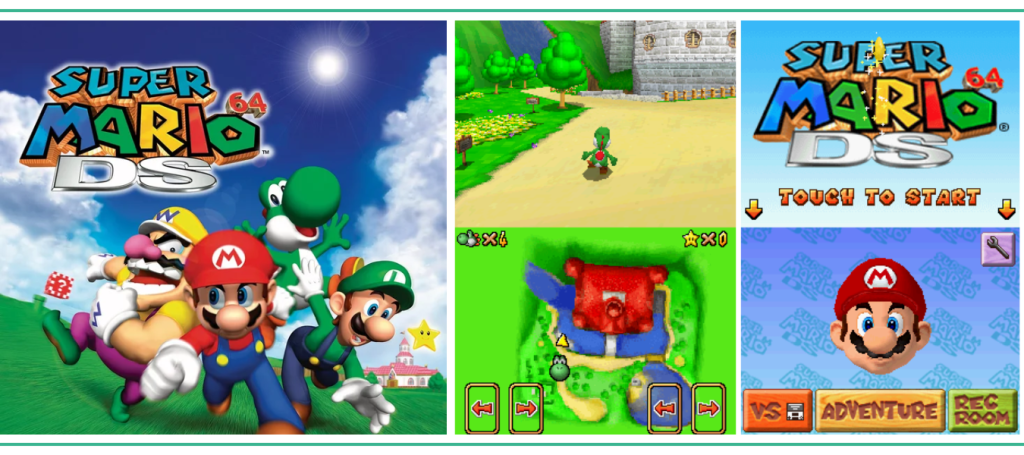
Super Mario 64 DS
It may seem blasphemous to include Super Mario 64 on a list of the best Nintendo DS games. Where there’s a legitimate argument to be made that Chrono Trigger (DS) is the greatest version of that game, it’s hard to claim the same here.
For many, the original Nintendo 64 game is untouchable in terms of look, feel, and all-around playability. For these same people, Super Mario 64 DS is untouchable in a “I will not touch this” sort of way. I am not one of these people. I did not grow up on the N64, nor did I revere Super Mario 64 as some sort of holy platformer. It was a good game; I never found it life-changing.
Super Mario 64 DS changed my tune. The portability brought new life to a game that seemed forever relegated to television screens. The 3D graphics—impressive on N64—felt groundbreaking on my tiny DS screen. And though the directional input on DS (as opposed to analog on N64) took some getting used to, before long it became second-nature.
And that’s before I even talk about the added content. With new stars to collect; the inclusion of Luigi, Wario, and Yoshi as playable characters; and even mini-games you could play solo or locally with other DS owners, Super Mario 64 DS is some of the most fun I’ve ever had with the franchise. My one complaint: Why hasn’t this game been brought to Nintendo Switch yet?
– Written by David Silbert
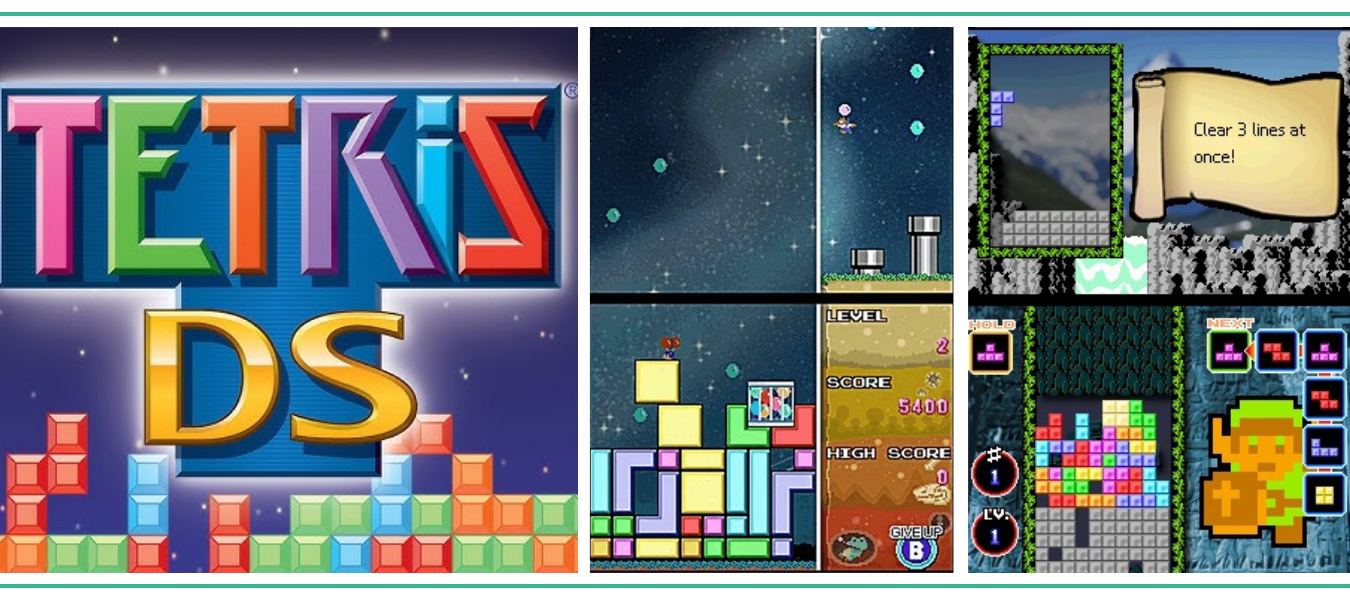
Tetris DS
What I admired most about the early years of the Nintendo DS was how every single game felt like a tech demo not just for the handheld itself, but for the future of gaming. No single DS title embodied this more than Tetris DS.
Obviously, everybody and their mother knows how Tetris works, but Nintendo decided to elevate the concept to even greater heights with Tetris DS. You could play a bog-standard version of the classic puzzler (known as “Standard Mode”), but even that had the top screen depicting 8-bit Mario running through classic Super Mario Bros. obstacles as you break lines.
Moreover, the other Tetris DS game modes also took inspiration from classic NES games: Mission Mode, for example, tasked the player with completing Tetris-specific challenges as quickly as possible with a Legend of Zelda theme, while Touch Mode had the player using the touchscreen to solve Tetris-related puzzles with a Balloon Fight surrounding theme. Every single unique mode took a fairly basic concept, flipped it on its head to maximize dual-screen and touchscreen capabilities, and wrapped it in some of the best Nintendo nostalgia imaginable.
It can be difficult to explain to someone why Tetris DS is so special to those who haven’t actually played it themselves. But what still enchants me about the game to this day is that, in many ways, it’s the ideal handheld game: no frills and no complications, just endless replayability, a clear aesthetic vision, and inventive gameplay challenges.
– Written by Sam Martinelli
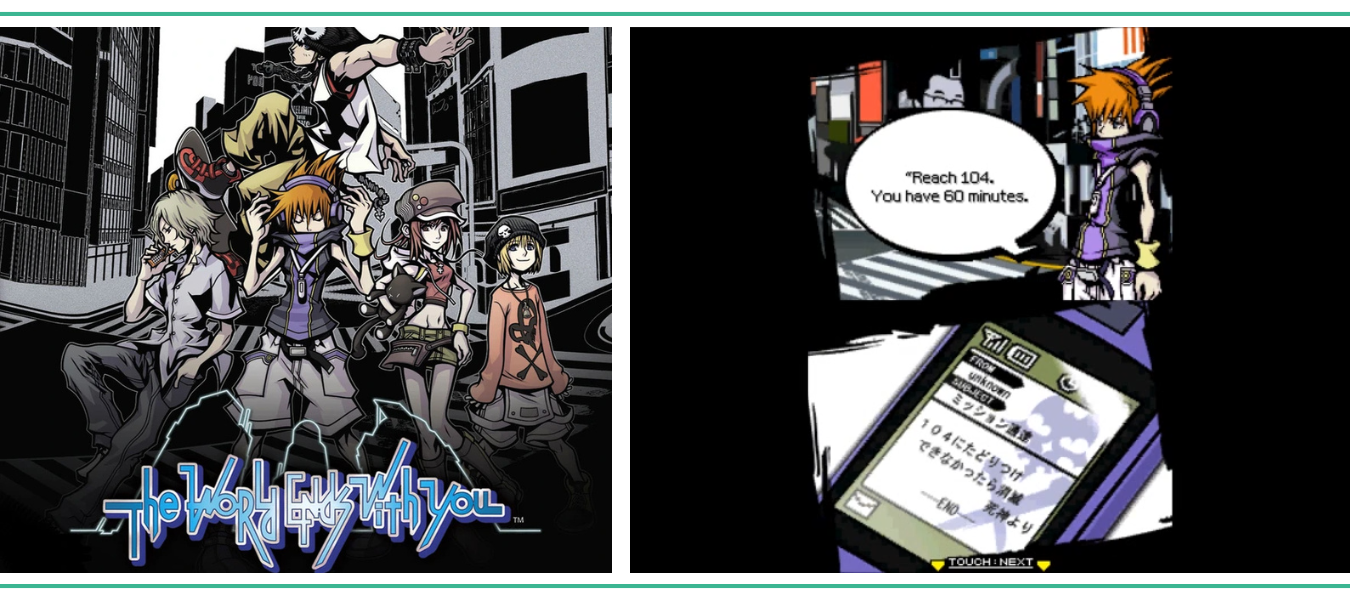
The World Ends with You
In 2007, back before Square Enix set ridiculous sales targets and could afford to swing and miss on a video game, it released The World Ends with You. A brash, hyper-stylized depiction of Shibuya, Tokyo, TWEWY melded hip-hop, rap, and punk rock with graffitied boardwalks, comic panel cutscenes, and Kingdom Hearts-ass characters. Needless to say, it was an immediate hit.
But The World Ends with You had more than just style going for it. Its gameplay, which tasked players with issuing character commands simultaneously via the touchscreen (via stylus) and the top screen (via face buttons), was messy, sometimes convoluted, but mostly great fun. The game also featured a surprisingly engaging story, with protagonist Neku and friends forced to play the Reapers’ Game to escape a three-week-long purgatory. Add in an addictive pin-based progression system, eccentric soundtrack, and Beyblade-inspired mini-game, and TWEWY solidified itself as quite possibly the most inventive RPG of its generation.
Above all else, though, The World Ends with You was proof that Square Enix still had creative runway beyond the standard “Final Fantasy, Kingdom Hearts, Dragon Quest” cadence. Sadly, the series would go dormant for 15 years, with calls for a sequel seemingly going unnoticed. Though fans finally got their long-awaited sequel with 2021’s NEO: The World Ends with You, the cavalry came far too late to capitalize on that original DS magic.
– Written by David Silbert
More Platform and Genre Recommendations
Enjoyed our best DS games piece? Explore these other articles from the Punished Favorites vault:
- The 50 Best Video Games of All Time
- 23 of the Best PlayStation 2 Games
- 10 of the Best SNES Games
- The Best Metroidvania Games To Play While You Wait for Silksong
- An Objective List of the Best Roguelike Games
- The Best Cozy Video Games
What Are Your Favorite Nintendo DS Games?
Let us know in the comments!
(Apr 15, 2025: Added Chrono Trigger (DS) and Super Mario 64 DS to the list.)
(May 13, 2025: Added Grand Theft Auto: Chinatown Wars to the list.)





































